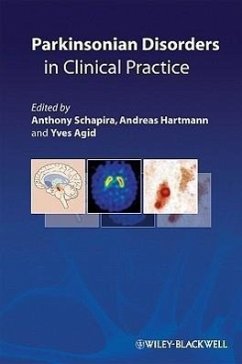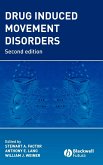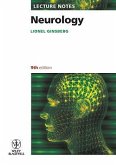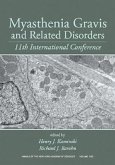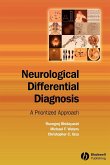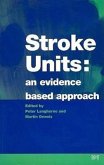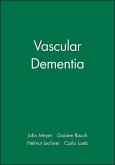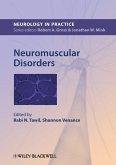Parkinsonian Disorders in Clinical Practice
Herausgeber: Schapira, Anthony; Agid, Yves; Hartmann, Andreas
Parkinsonian Disorders in Clinical Practice
Herausgeber: Schapira, Anthony; Agid, Yves; Hartmann, Andreas
- Broschiertes Buch
- Merkliste
- Auf die Merkliste
- Bewerten Bewerten
- Teilen
- Produkt teilen
- Produkterinnerung
- Produkterinnerung
This book gives the reader an up-to-date, clear and logical idea of what caring for parkinsonian patients entails - a challenge that clinicians will face for many years to come. It is split into three sections: Section 1: A compilation of the major brain lesions typically seen in PD Section 2: Treatment options in PD Section 3: 25 cases designed to test the reader and the practical application of the information supplied in the other sections.
Andere Kunden interessierten sich auch für
![Drug Induced Movement Disorders Drug Induced Movement Disorders]() Factor S.A. Stewart / Lang A. Anthony / Weiner W.J. WilliamDrug Induced Movement Disorders270,99 €
Factor S.A. Stewart / Lang A. Anthony / Weiner W.J. WilliamDrug Induced Movement Disorders270,99 €![Neurology Neurology]() Lionel GinsbergNeurology51,99 €
Lionel GinsbergNeurology51,99 €![Myasthenia Gravis and Related Disorders Myasthenia Gravis and Related Disorders]() KaminskyMyasthenia Gravis and Related Disorders200,99 €
KaminskyMyasthenia Gravis and Related Disorders200,99 €![Neurological Differential Diagnosis Neurological Differential Diagnosis]() Roongroj BhidayasiriNeurological Differential Diagnosis135,99 €
Roongroj BhidayasiriNeurological Differential Diagnosis135,99 €![Stroke Units Stroke Units]() Stroke Units99,99 €
Stroke Units99,99 €![Vascular Dementia Vascular Dementia]() Vascular Dementia280,99 €
Vascular Dementia280,99 €![Neuromuscular Disorders Neuromuscular Disorders]() Neuromuscular Disorders116,99 €
Neuromuscular Disorders116,99 €-
-
-
This book gives the reader an up-to-date, clear and logical idea of what caring for parkinsonian patients entails - a challenge that clinicians will face for many years to come. It is split into three sections: Section 1: A compilation of the major brain lesions typically seen in PD Section 2: Treatment options in PD Section 3: 25 cases designed to test the reader and the practical application of the information supplied in the other sections.
Hinweis: Dieser Artikel kann nur an eine deutsche Lieferadresse ausgeliefert werden.
Hinweis: Dieser Artikel kann nur an eine deutsche Lieferadresse ausgeliefert werden.
Produktdetails
- Produktdetails
- Verlag: Wiley
- Seitenzahl: 208
- Erscheinungstermin: 1. Juni 2009
- Englisch
- Abmessung: 226mm x 150mm x 13mm
- Gewicht: 376g
- ISBN-13: 9781405196017
- ISBN-10: 1405196017
- Artikelnr.: 26893000
- Herstellerkennzeichnung
- Libri GmbH
- Europaallee 1
- 36244 Bad Hersfeld
- gpsr@libri.de
- Verlag: Wiley
- Seitenzahl: 208
- Erscheinungstermin: 1. Juni 2009
- Englisch
- Abmessung: 226mm x 150mm x 13mm
- Gewicht: 376g
- ISBN-13: 9781405196017
- ISBN-10: 1405196017
- Artikelnr.: 26893000
- Herstellerkennzeichnung
- Libri GmbH
- Europaallee 1
- 36244 Bad Hersfeld
- gpsr@libri.de
Anthony HV Schapira, MD DSC, FRCP, FMedSci, Professor and Head of Department University College of Clinical Neurosciences, Institute of Neurology, University College London, Queen Square, London UK. Professor of Neurology, National Hospital for Neurology and Neurosurgery and Roayl Free Hospital, London, UK. Andreas Hartmann, MD, Clinical Investigation Center, Pitie-Salpetriere Hopital, Paris, France. Federation of Nervous System Disease, Pitie-Salpetriere Hopital, Paris, France. National Institute of Health and Medical Research, Paris, France. Pierre and MAric Curie University,?Paris, France. Yves Agid, MD, PhD, Clinical Investigation Center, Pitie-Salpetriere Hopital, Paris, France. Federation of Nervous System Disease, Pitie-Salpetriere Hopital, Paris, France. National Institute of Health and Medical Research, Paris, France. Pierre and MAric Curie University,?Paris, France.
Preface.
Introduction.
1 What is Parkinson's disease? From pathophysiology to symptoms (Andreas
Hartmann, Yves Agid, Anthony Schapira).
I. Pathophysiology of Parkinson's disease.
1. Dysfunctions of the main neuronal pathways in Parkinson's disease.
a. An overview of neuronal systems affected in Parkinson's disease.
b. Dopaminergic neurons.
c. Non-dopaminergic neurons.
2. Consequences of dopaminergic neuronal lesions on basal ganglia circuits.
a. The dopaminergic nigrostriatal system: pre- and postsynaptic
compensatory mechanisms.
b. Pathologic alterations of nigrostriatal circuits in Parkinson's disease.
3. Histopathology of Parkinson's disease.
4. The etiopathogenesis of Parkinson's disease.
a. The genetics of Parkinson's disease: any clues for the sporadic forms?
b. Relevant environmental factors: focus on mitochondria.
c. Mechanisms of cell death in Parkinson's disease: therapeutic
implications.
5. Conclusions.
a. Parkinson's disease or Parkinson's syndromes?
b. What Parkinson's disease is not.
II. Clinical features of Parkinson's disease.
1. Motor symptoms.
2. Non-motor symptoms.
a. Depression.
b. Apathy.
c. Cognitive impairment.
d. Sleep.
e. Autonomic dysfunction.
f. Sensory symptoms.
3. The different forms of Parkinson's disease: relevance for prognosis.
4. The differential diagnosis of Parkinson's disease.
5. Treatment-related symptoms.
a. Motor complications.
b. Non-motor complications.
2 Treatment of Parkinson's disease (Anthony Schapira, Andreas Hartmann,
Yves Agid).
I. Antiparkinsonian agents.
1. Levodopa.
2. COMT inhibitors.
3. Dopamine agonists.
4. Monoamine oxidase B inhibitors.
5. Other drugs.
II. Medical management.
1. Initiation of treatment.
2. Maintenance of treatment (Fig. 2.7).
3. Motor complications.
4. Management of non-motor complications.
III. Non-medical management.
1. Surgery.
2. Destructive lesions.
3. Cell therapy.
4. Growth factors.
IV. Neuroprotection.
1. MAO-B inhibitors.
2. Dopamine agonists.
3. Coenzyme Q.
4. Creatine.
5. Antiapoptotic drugs.
V. Conclusion.
3 Case studies.
Case studies-diagnostic index.
Index.
Introduction.
1 What is Parkinson's disease? From pathophysiology to symptoms (Andreas
Hartmann, Yves Agid, Anthony Schapira).
I. Pathophysiology of Parkinson's disease.
1. Dysfunctions of the main neuronal pathways in Parkinson's disease.
a. An overview of neuronal systems affected in Parkinson's disease.
b. Dopaminergic neurons.
c. Non-dopaminergic neurons.
2. Consequences of dopaminergic neuronal lesions on basal ganglia circuits.
a. The dopaminergic nigrostriatal system: pre- and postsynaptic
compensatory mechanisms.
b. Pathologic alterations of nigrostriatal circuits in Parkinson's disease.
3. Histopathology of Parkinson's disease.
4. The etiopathogenesis of Parkinson's disease.
a. The genetics of Parkinson's disease: any clues for the sporadic forms?
b. Relevant environmental factors: focus on mitochondria.
c. Mechanisms of cell death in Parkinson's disease: therapeutic
implications.
5. Conclusions.
a. Parkinson's disease or Parkinson's syndromes?
b. What Parkinson's disease is not.
II. Clinical features of Parkinson's disease.
1. Motor symptoms.
2. Non-motor symptoms.
a. Depression.
b. Apathy.
c. Cognitive impairment.
d. Sleep.
e. Autonomic dysfunction.
f. Sensory symptoms.
3. The different forms of Parkinson's disease: relevance for prognosis.
4. The differential diagnosis of Parkinson's disease.
5. Treatment-related symptoms.
a. Motor complications.
b. Non-motor complications.
2 Treatment of Parkinson's disease (Anthony Schapira, Andreas Hartmann,
Yves Agid).
I. Antiparkinsonian agents.
1. Levodopa.
2. COMT inhibitors.
3. Dopamine agonists.
4. Monoamine oxidase B inhibitors.
5. Other drugs.
II. Medical management.
1. Initiation of treatment.
2. Maintenance of treatment (Fig. 2.7).
3. Motor complications.
4. Management of non-motor complications.
III. Non-medical management.
1. Surgery.
2. Destructive lesions.
3. Cell therapy.
4. Growth factors.
IV. Neuroprotection.
1. MAO-B inhibitors.
2. Dopamine agonists.
3. Coenzyme Q.
4. Creatine.
5. Antiapoptotic drugs.
V. Conclusion.
3 Case studies.
Case studies-diagnostic index.
Index.
Preface.
Introduction.
1 What is Parkinson's disease? From pathophysiology to symptoms (Andreas
Hartmann, Yves Agid, Anthony Schapira).
I. Pathophysiology of Parkinson's disease.
1. Dysfunctions of the main neuronal pathways in Parkinson's disease.
a. An overview of neuronal systems affected in Parkinson's disease.
b. Dopaminergic neurons.
c. Non-dopaminergic neurons.
2. Consequences of dopaminergic neuronal lesions on basal ganglia circuits.
a. The dopaminergic nigrostriatal system: pre- and postsynaptic
compensatory mechanisms.
b. Pathologic alterations of nigrostriatal circuits in Parkinson's disease.
3. Histopathology of Parkinson's disease.
4. The etiopathogenesis of Parkinson's disease.
a. The genetics of Parkinson's disease: any clues for the sporadic forms?
b. Relevant environmental factors: focus on mitochondria.
c. Mechanisms of cell death in Parkinson's disease: therapeutic
implications.
5. Conclusions.
a. Parkinson's disease or Parkinson's syndromes?
b. What Parkinson's disease is not.
II. Clinical features of Parkinson's disease.
1. Motor symptoms.
2. Non-motor symptoms.
a. Depression.
b. Apathy.
c. Cognitive impairment.
d. Sleep.
e. Autonomic dysfunction.
f. Sensory symptoms.
3. The different forms of Parkinson's disease: relevance for prognosis.
4. The differential diagnosis of Parkinson's disease.
5. Treatment-related symptoms.
a. Motor complications.
b. Non-motor complications.
2 Treatment of Parkinson's disease (Anthony Schapira, Andreas Hartmann,
Yves Agid).
I. Antiparkinsonian agents.
1. Levodopa.
2. COMT inhibitors.
3. Dopamine agonists.
4. Monoamine oxidase B inhibitors.
5. Other drugs.
II. Medical management.
1. Initiation of treatment.
2. Maintenance of treatment (Fig. 2.7).
3. Motor complications.
4. Management of non-motor complications.
III. Non-medical management.
1. Surgery.
2. Destructive lesions.
3. Cell therapy.
4. Growth factors.
IV. Neuroprotection.
1. MAO-B inhibitors.
2. Dopamine agonists.
3. Coenzyme Q.
4. Creatine.
5. Antiapoptotic drugs.
V. Conclusion.
3 Case studies.
Case studies-diagnostic index.
Index.
Introduction.
1 What is Parkinson's disease? From pathophysiology to symptoms (Andreas
Hartmann, Yves Agid, Anthony Schapira).
I. Pathophysiology of Parkinson's disease.
1. Dysfunctions of the main neuronal pathways in Parkinson's disease.
a. An overview of neuronal systems affected in Parkinson's disease.
b. Dopaminergic neurons.
c. Non-dopaminergic neurons.
2. Consequences of dopaminergic neuronal lesions on basal ganglia circuits.
a. The dopaminergic nigrostriatal system: pre- and postsynaptic
compensatory mechanisms.
b. Pathologic alterations of nigrostriatal circuits in Parkinson's disease.
3. Histopathology of Parkinson's disease.
4. The etiopathogenesis of Parkinson's disease.
a. The genetics of Parkinson's disease: any clues for the sporadic forms?
b. Relevant environmental factors: focus on mitochondria.
c. Mechanisms of cell death in Parkinson's disease: therapeutic
implications.
5. Conclusions.
a. Parkinson's disease or Parkinson's syndromes?
b. What Parkinson's disease is not.
II. Clinical features of Parkinson's disease.
1. Motor symptoms.
2. Non-motor symptoms.
a. Depression.
b. Apathy.
c. Cognitive impairment.
d. Sleep.
e. Autonomic dysfunction.
f. Sensory symptoms.
3. The different forms of Parkinson's disease: relevance for prognosis.
4. The differential diagnosis of Parkinson's disease.
5. Treatment-related symptoms.
a. Motor complications.
b. Non-motor complications.
2 Treatment of Parkinson's disease (Anthony Schapira, Andreas Hartmann,
Yves Agid).
I. Antiparkinsonian agents.
1. Levodopa.
2. COMT inhibitors.
3. Dopamine agonists.
4. Monoamine oxidase B inhibitors.
5. Other drugs.
II. Medical management.
1. Initiation of treatment.
2. Maintenance of treatment (Fig. 2.7).
3. Motor complications.
4. Management of non-motor complications.
III. Non-medical management.
1. Surgery.
2. Destructive lesions.
3. Cell therapy.
4. Growth factors.
IV. Neuroprotection.
1. MAO-B inhibitors.
2. Dopamine agonists.
3. Coenzyme Q.
4. Creatine.
5. Antiapoptotic drugs.
V. Conclusion.
3 Case studies.
Case studies-diagnostic index.
Index.

